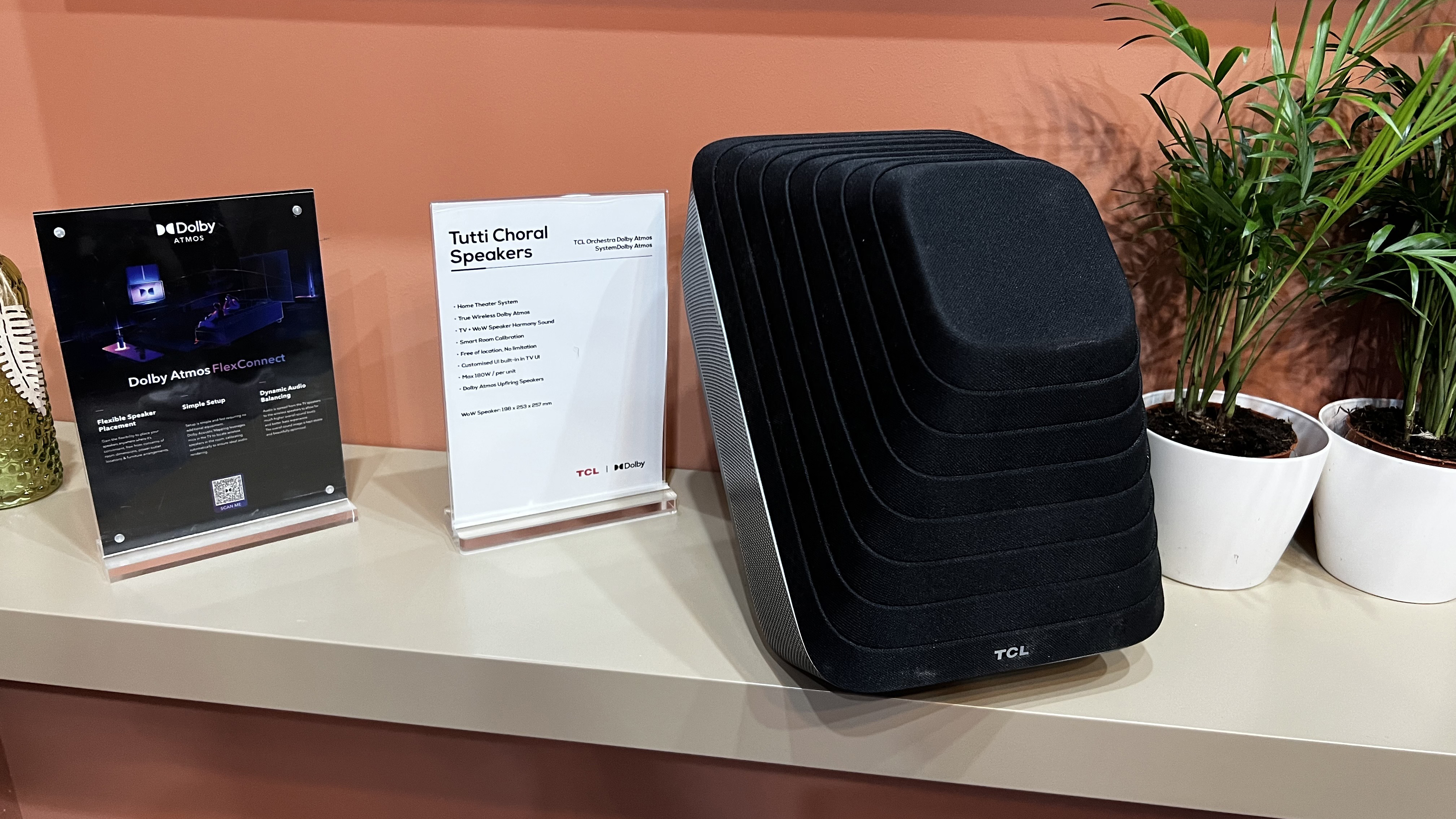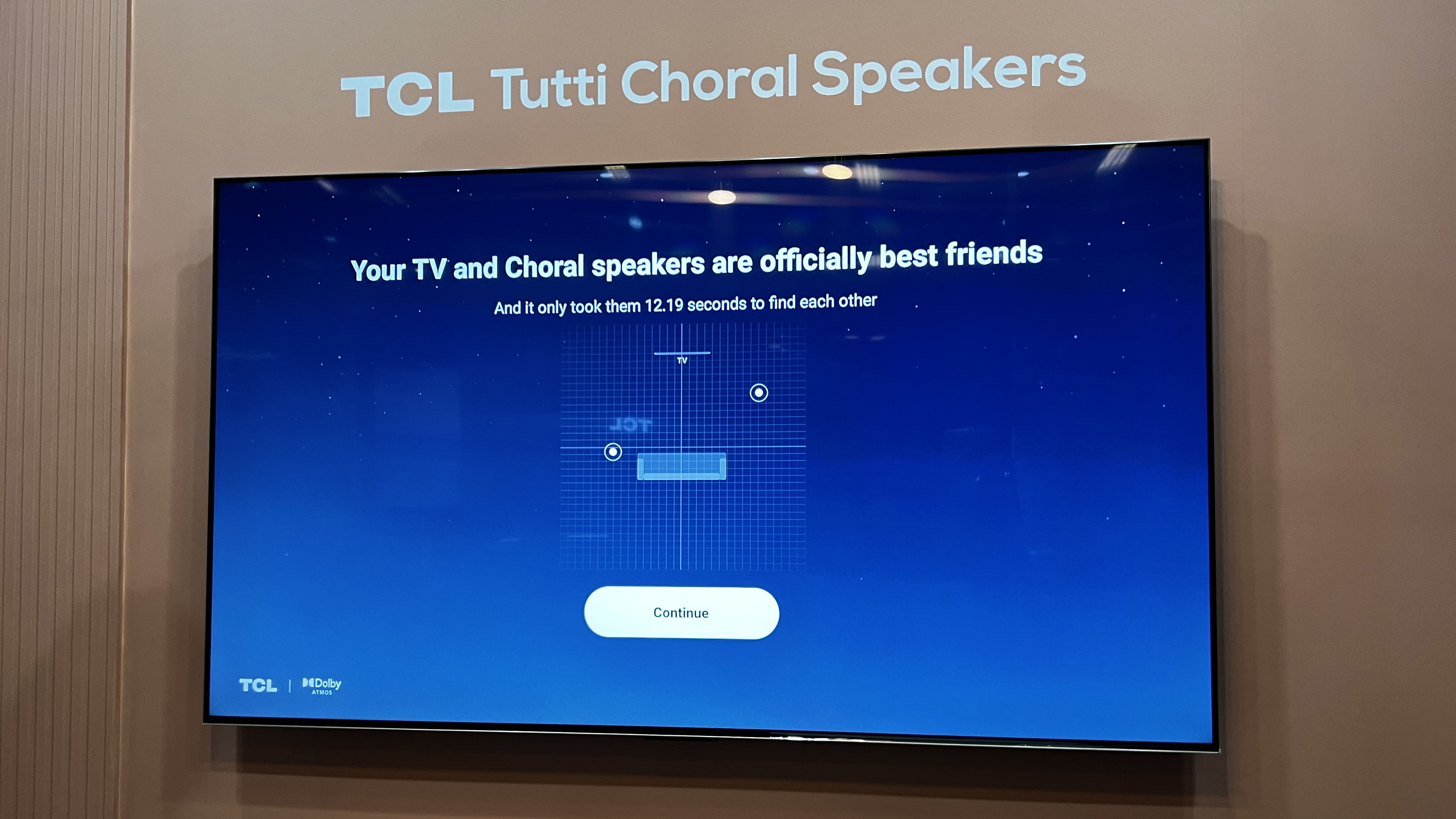
In the IFA 2023 tech trade show, there are two different excellent demos of wireless home theater sound. The first is the future of Dolby Atmos with current styles of speaker setup, but the second tech, from Dolby itself, is even more groundbreaking, and may need us to change how we think about our home theater sound, and how we plan movie rooms.
It's called Dolby Atmos FlexConnect, and we covered the announcement in full here, but here's the short version: FlexConnect is a wireless tech that will enable compatible speakers to connect to compatible TVs wirelessly, and to create a convincing soundstage based on Atmos' 3D data for you from any combination of mismatched speakers in any location in your room.
So, we're not simply talking about the ability to a traditional 5.1.4-channel system wirelessly. When I spoke to the people from Dolby, they said that we need to be thinking past the idea of channels when we talk about what FlexConnect can do.
Because the idea is that you can mix and match what speakers will be used – not even in pairs, just whatever compatible speaker you feel like using – the goal of the system is to simply create sound in the most optimal way possible for your speakers' locations, so the whole idea of channels becomes arguably unhelpful. You won't have to think in terms of having front left, front right, center, rear left and rear right speakers placed evenly around any more. Just put the speakers wherever works for you, and FlexConnect will even their sound out based on the object-based 3D sound of a Dolby Atmos soundtrack.
It's kind of like how Dolby Atmos works with headphones such as AirPods Pro 2 – there are only two speakers there, but a 3D soundscape is created for you, because clever processing know where those speakers are, and what they can do.
The process
Let's start with how it will work in practice. Dolby had a demo set up with TCL, which will be the first company to release compatible products, so I got to run through the whole thing at the TCL booth. They placed two prototype TCL FlexConnect-compatible speakers in the room, and then began the FlexConnect process. First, it detects compatible speakers, and you can confirm which ones you'll use in your setup. Then, the system plays audio tones through the speakers, which are picked up by a microphone in the TV.

These tones are used to first map the locations of your speakers in relation to the TV, and to test the capabilities of the speakers – whether they have upfiring height drivers, what kind of dynamic range they have, and so on. The system is also assessing the room at this time, including how the sound reflects in it.
Then it crunches this data to render a processing model for your exact setup that will create the best possible bubble of sound, from both the wireless speakers and the TV itself.
So, in the case of the demo I heard, with two identical TCL speakers that have five drivers each, including two upfiring at different angles per speaker, plus multiple speakers in the TV, the system was able to work real magic.
Side sounds came convincingly from pretty much the direct left and right of me, even though the speakers were at the front of the room (at first), along with impressive height effects that a certain amount of movement in space. There were even moments where the psychoacoustic trickery had me feeling like sounds were coming from behind me, which is rare from any of the best soundbars, which similarly are spreading sound from the front.
Then, we moved one speaker, so instead of them being roughly in a standard stereo separation in front, one was to the left of me, and marginally behind. We ran through the setup process again, and sure enough the system correctly identified the change in the physical position – you can see that second configuration below, the first configuration can be seen in the image at the top of this page.

We tested the ability of the new setup to spread sound evenly using a soccer game, and while the TV seemed to be handling a lot of the more direct sounds (the commentators' voices, and the feet connecting with the ball), there was a spread of crowd sound around me that was hard to fault. The uneven setup didn't feel uneven, it just felt like the speakers were creating a great ambient spread of cheering and yelling from the stadium in the room.
That was still with two identical speakers, though. Dolby explained that if you have two mismatched speakers, the system will make full use of whatever both speakers can do, but there'll be more acoustic processing going on to create an even sound.
So, if you want one big beefy speaker with a huge range and one more basic one, time-of-flight trickery and other psychoacoustic techniques will be used to make sure the sound isn't lopsided – the bass and power of the one speaker is balanced against whatever the other can do. That's the promise, anyway – that wasn't being demoed.
Current limitations, and the future
At launch, Dolby Atmos FlexConnect will have the ability to connect to only two speakers from a TV – though a separate subwoofer could be used as part of that system too, according to Dolby. That certainly sounds like an interesting and tempting alternative to a soundbar – instead of a block under your TV, you could just have a nice speaker on a bookshelf and another on a side table, or something, and the system would make them deliver the clarity of a soundbar. For aesthetes, these could even be speakers built into lamps, or that look like objets d'art on your shelves.
But still, even with the five drivers per speaker and multiple drivers in the TV in our TCL demo, the effect wasn't as good as you get from the very best Dolby Atmos soundbar setups – something like the Samsung HW-Q990C, with its giant array of drivers in the soundbar, plus two physical speakers behind you, with three drivers in each.
However, the system can technically support six speakers. Dolby has decided to launch it with support for two because it wants to keep the concept simple initially, but the expansion to six could come whenever it seems like the world is ready for it.
Similarly, at the moment, the only part of the calibration that's imprecise is where you'll be sitting in relation to the speakers. In a perfect system, FlexConnect would measure your location too, and tweak the system's output to compensate. But that would add another layer of complexity to setting it up, and like I said, Dolby wants the first version to be simple and easy. Much like the upgrade to the number of speakers, the ability to adapt to your location can be added whenever it seems prudent – I'm imagining something like the Sonos Trueplay process for its surround setups, which asks you to hold your iPhone up in your normal sitting position.
Both of these will surely come before too long, because it'll be a huge boon to the installers who set up serious home theater rooms for other people. One of the advantages of the FlexConnect system is that it could make life much easier for custom installers, as well as regular people at home, because it means if someone wants their home theater to be in a really awkward room, or to work in a very specific way aesthetically, installers no longer have to deal with speakers being in non-optimal positions for a 7.1.4 system, or whatever's being installed. After all – we're past channels, remember?
However, like even the initial release of FlexConnect with TCL, all of this is vague right now. The TCL speakers were prototypes – it seems likely that TCL will launch those speakers with that kind of driver configuration, but not necessary in the exact design you see on this page. And while I've talked a lot about mismatched speakers, there's absolutely no official word on when non-TCL products that support FlexConnect will appear. They will come, but I don't know if we're talking months or years away on that. But I'll be waiting eagerly either way, because I think it's the biggest thing to happen to home theater sound since… well, Dolby Atmos.
You might also like
"sound" - Google News
September 04, 2023 at 12:28AM
https://ift.tt/iom8zfO
I tried Dolby Atmos FlexConnect, and it's a game-changer for home theater sound - TechRadar
"sound" - Google News
https://ift.tt/FGjJ9qY
Shoes Man Tutorial
Pos News Update
Meme Update
Korean Entertainment News
Japan News Update

No comments:
Post a Comment